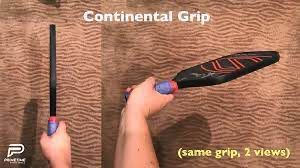Adding spin to the ball in pickleball is something that people ask how to do all the time. So, I ask them why they want it as a part of their game.
A common answer is that they have struggled in handling the ball when they’re trying to hit a ball that already has spin and want to do that against their opponents.
I do often find that those who give that sort of an answer are looking to incorporate topspin a little too early and what they’re maybe neglecting is gaining consistency with the more fundamental shots, such as forehand and backhand dinks and third shot drops.
It seemed like a great topic for a blog post...
Topspin is when a player brushes upwards on the ball with their paddle creating a forward rotation motion on the ball itself.
There is also backspin which essentially means the ball spins backward, however, we’re here just for topspin right now.
Topspin will cause the ball to “drop” or “sink” towards the ground faster than a ball that has no spin at all and it’s extremely popular to use topspin because it can cause the ball to drop down to one's feet forcing the person to hit up on the ball.
Very effective topspin or repetitive topspin shots can easily create an offensive opportunity. Here are some tips to help you add topspin to your game:
Brush Don’t Swing
The stroke to add topspin does not require any backswing and very little push forward, you want to actually brush upwards on the ball.
This is made easier with a tennis racquet where strings can absorb the ball better than a solid paddle, however, paddle technology is evolving, so newer and different materials and core thickness are impacting how much the paddle will absorb impact and allow you to spin the ball.
Back in the day, paddles had smoother surfaces and the materials were less innovative (wooden Diller paddles and little-to-no grit), so the paddle couldn’t grab the ball the way it does today. These days, raw carbon fiber seems to create a cushioning (or trampoline) effect like no other.
Low to High
This is applicable with the body, but here I’m mostly referring to the paddle, you want the path of this paddle to go from low (below the ball) to high (paddle ending up near the shoulders).
Imagine swiping upwards with the paddle, this is the main portion of the swing. So, how is this applicable with regards to the body? You are aiming to keep the hips open and square to the net - get the hips low and rise up with the shot.
Stay Loose
It’s important to keep the body calm and relaxed when practicing topspin.
Keep the swing calm and in control and be sure to stabilize or lock in the wrist. A loose wrist will probably send the ball somewhere you don’t want it to go, like into the net or through the back of the court.
Keep your eye on the ball, aim to make clean contact with the ball, and stay calm.
Grip It
Most people slightly change their grip from continental to an eastern or semi-western grip, the reason behind this is to close the paddle face, therefore, keeping the height of the ball lower and grabbing onto the ball better. Although the continental grip is the most popular to use in pickleball, it will keep the paddle face too open to incorporate really effective topspin.

-Jan-28-2023-12-10-05-9384-PM.png?upscale=true&width=600&upscale=true&name=unnamed%20(1)-Jan-28-2023-12-10-05-9384-PM.png)
Start Slow and Low
By starting slow and getting low, under the ball you will start to develop a feel for this shot. Creating that feeling and then building familiarity and muscle memory is key for this shot (and any other shot you want to develop).
As you start to get the feel for topspin, slowly start increasing the power you put behind the shot, while maintaining those same or similar mechanics (low to high, stable wrist).
The topspin groundstroke which more often occurs from the baseline will look and feel different (close the body off with your non-dominant shoulder) than a topspin forehand dink at the non-volley line (keep the body more open and squared off to the net).
Ultimately, look to create that higher trajectory as the ball crosses the net and dip downwards very quickly.
You Can Practice Alone
Don’t have someone to drill topspin with? You can either self-feed the ball to your forehand side at various distances from the net or you can hit the ball against a wall.
Once you have made contact with the ball, be sure to watch it travel away from the paddle and keep an eye on whether the ball spins or travels through the air flat. As you become more familiar with the motions, you will start to see the ball spin away from you more and more aggressively.
Final thoughts
Finally, keep in mind that adding topspin can also make the ball bounce high, so although it often causes difficulty for the receiving player, if they can read the spin well, they’ll stick with the trajectory of the ball and might utilize the height of the bounce to their advantage.
This article was taken from our 'Control the Kitchen' Newsletter, if you're interested in receiving more content like this, please feel free to sign up using the subscribe section located at the bottom left of this page (or underneath the article if you're on mobile), thanks!